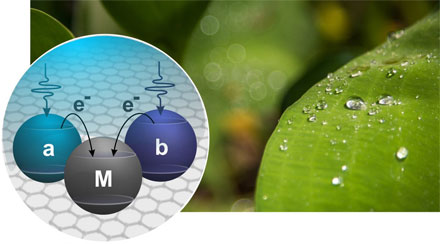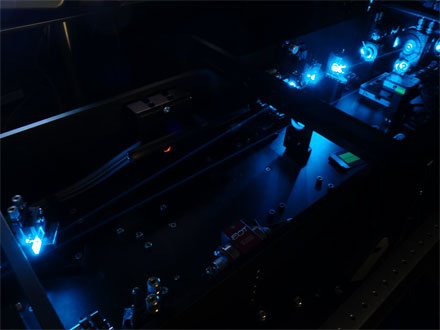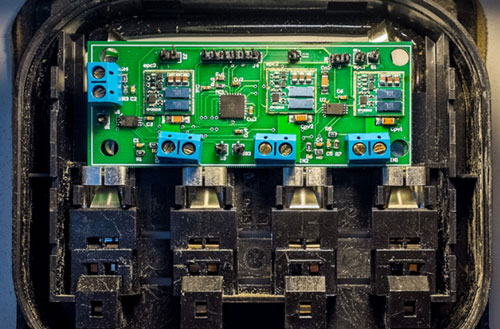Quantum Photocell Could Boost Solar Cell Efficiency
Photonics.comDec 2016
Researchers from the University of California, Riverside (UCR) set out to design a simple photocell that could match the amount of solar power generated to the average power demand, and suppress energy fluctuations to avoid the accumulation of excess energy.
“Plants have evolved to do this, but current affordable solar cells — which are at best 20 percent efficient — do not control these sudden changes in solar power,” said primary researcher Nathaniel Gabor. “That results in a lot of wasted energy and helps prevent wide-scale adoption of solar cells as an energy source.”

In a light harvesting quantum photocell, particles of light (photons) can efficiently generate electrons. When two absorbing channels are used, solar power entering the system through the two absorbers (a and b) efficiently generates power in the machine (M). Courtesy of Nathaniel Gabor and Tamar Melen.
The researchers compared the theoretical minimum energy fluctuations in nanoscale quantum heat engine photocells: one in which the photocell absorbed one color of light, and the other in which the photocell absorbed two colors. They found that fluctuations were naturally suppressed in the two-channel photocell. Essentially, one channel absorbed at a wavelength at which the average input power was high, while the other channel absorbed at a wavelength at which the average input power was low. The photocell switched between high and low power to convert varying levels of solar energy into a steady-state output.
When the team applied its models to the measured solar spectrum on Earth’s surface, it discovered that the absorption of green light, the most radiant portion of the solar power spectrum per unit wavelength, provided no inherent regulatory benefit, a finding that led them to reject green light for use in a photocell whose primary role would be the regulation of energy flow.
The team optimized the photocell parameters to reduce solar energy fluctuations and found that the absorption spectrum was nearly identical to the absorption spectrum observed in photosynthetic green plants. This discovery led the researchers to propose that the natural regulation of energy found in the quantum heat engine photocell could play a role in photosynthesis, possibly accounting for the predominance of green as a plant color.
Unrelated research has shown that some molecular structures in plants, including chlorophyll a and b molecules, could be important in preventing plants from accumulating excess energy. The molecular structure of the quantum heat engine photocell was found to be similar to the structure of photosynthetic molecules that incorporate pairs of chlorophyll.
Gabor and his team are potentially the first to connect quantum mechanical structure to the greenness of plants. Their work provides a set of tests for researchers aiming to verify natural regulation of solar energy. Additionally, their design allows regulation without active input, a process made possible by the photocell's quantum mechanical structure.
Unrelated research has shown that some molecular structures in plants, including chlorophyll a and b molecules, could be important in preventing plants from accumulating excess energy. The molecular structure of the quantum heat engine photocell was found to be similar to the structure of photosynthetic molecules that incorporate pairs of chlorophyll.
Gabor and his team are potentially the first to connect quantum mechanical structure to the greenness of plants. Their work provides a set of tests for researchers aiming to verify natural regulation of solar energy. Additionally, their design allows regulation without active input, a process made possible by the photocell's quantum mechanical structure.

Nathan Gabor's Laboratory of Quantum Materials Optoelectronics utilizes infrared laser spectroscopy techniques to explore natural regulation in quantum photocells composed of two-dimensional semiconductors. Courtesy of Max Grossnickle and QMO Lab.
The research was published in Nano Letters (doi: 10.1021/acs.nanolett.6b03136)









